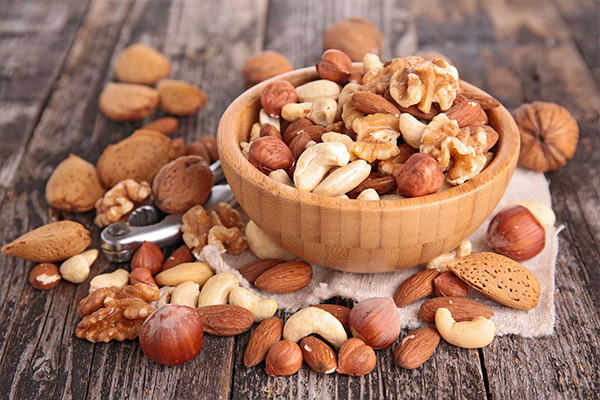Studies are showing that nuts are filling, nutrient rich, healthy snack for type 2 diabetics. Nuts have also been shown to improve good cholesterol and lower bad cholesterol. We can enjoy a variety of nuts when consuming a healthy serving size that is an ounce, or about the amount that would fit in the palm of the hand! So why should we all be aiming for three servings of nuts each week?
A recent study published in Circulation Research found a lower risk of heart disease and death in people with Type 2 diabetes who ate nuts. “They showed a significant reduction in cardiovascular risk factors with diabetics when they’re eating at least five servings of nuts a week,” says Julia Zumpano, RD, LD, who did not take part in the study. “The serving size was about an ounce – 28 grams – which is exactly what we recommend.”
What are the best nuts for type 2’s?
The type of nut doesn’t seem to really matter as they all have healthy properties! Most of them offer some kind of benefit, from cardiovascular health to Omega-3 oils. But, here are some special things about our most favorite ones.
- Almonds contain a lot of nutrients, particularly vitamin E, reduce bad cholesterol, they actually contain a lot of dairy and are even better for your bones than dairy! This means that almond milk is actually an optimal choice for people concerned with their bone health, and for anyone looking to get enough calcium.
- Walnuts contain healthy omega-3 fatty acids, rich in antioxidants, reduce inflammation
- Cashews offers lots of magnesium, they are low in sugar and rich in fiber
- Macadamia are rich in heart-healthy monounsaturated fats. Researchers believe the heart benefits of macadamia nuts may come from their high monounsaturated fat content.
- Pecans are a good source of calcium, magnesium, and potassium, which help lower blood pressure.
- Brazil nuts, some studies show that the selenium in Brazil nuts can help to lower insulin levels and boost insulin sensitivity, improving blood sugar levels in people with type 2 diabetes.
- Peanuts - while the best known nut isn’t really a nut, but a legume, they are very healthy regardless of what we consider them as. They may lower the risk of cardiovascular disease and lower high blood pressure.
Along with the nutritional values, each of these will also make you feel more full and satisfied in your meals because of the high protein and fiber content. Besides being great for us while improving texture and flavor to your everyday snacks and meals. Try adding a quarter cup of your favorite nuts to your morning cereal or yogurt or afternoon smoothie or salad. Create your own trail mix for a quick snack on the go or try a new nutty type 2 friendly dessert recipe!
Nuts can also create great substitutes for dairy. Today many people are experiencing negative reactions to dairy including stomach and headaches and allergic reactions. As we age we may also become more sensitive to dairy. Some people are also considering the environmental benefits of switching to plant based milks and other dairy products. Whatever the reason, nuts are no longer a food you just eat raw, there are so many uses.
For example, when you make your favorite healthy pasta or dessert, use cashew ricotta instead! You can easily make cashew ricotta in your blender today in two easy steps.
Cashew Ricotta Cheese Recipe:
Ingredients:
- 1 ½ cups raw cashews, soaked
- ½ cup water
- juice of 1 large lemon or 1 tablespoon apple cider vinegar
- 1 – 2 tablespoons nutritional yeast, optional
- 1 small garlic clove
- ½ teaspoon onion powder
- himalayan sea salt & cracked pepper, to taste
Step 1: It’s best to soak your cashews in water before starting. There are 2 ways to soak:
- Soak cashew in cool water for 2 – 3 hours, drain and rinse (this method is best for digestion).
- For a quick method of soaking, let cashews sit in hot water for 5 minutes, drain, rinse and continue with the recipe.
Step 2: Next, place cashews, water, lemon juice/apple cider vinegar, garlic, onion powder, salt, and pepper in a food processor/blender and blend until creamy. Place in a covered container and place in the fridge until ready to use. Or use right away in any recipe calling for ricotta cheese.
Almost all nuts offer something good for people with diabetes when we eat them in the recommended serving size. Salted or sugared nuts, however, should be avoided. Sometimes nut blends or pre-mixed trail mixes contain seasonings that have excess sodium, oils or sugars. These can add hundreds of unwanted calories and cause changes in blood sugar. Additionally, excessive salt consumption is consistently linked to an increased risk of heart disease.







